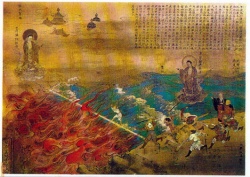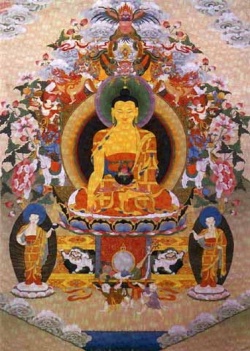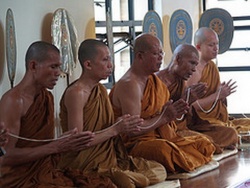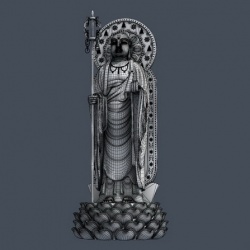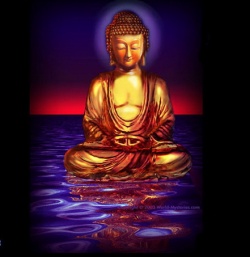Mahayana sutras origin discussion
First Council
Also known as 500 Council, Theravada Council", TheFirst Compilation, etc. The assembly of 500 leading Bhikhus gathered for 3 months after the Buddha's death to compile the Buddhist sutras. It was held at Cave of the Seven Leaves near Rajagaha.
In the assembly, Ananda recited the Sutta-pitaka, Upali recited the Rules of Disciplines of the Order, i.e., Vinaya-pitaka, and Kassapa recited the Abhidhamma. Thus, the Tripitaka was adopted as a unity of doctrines and opinions within the religious order, and also an orthodox teaching for the Buddhists to follow.
Mahasanghika and Sthavira are known as two earliest sects in Hinayana. Mahasanghika is said to be the basis of the development of the Mahayana Buddhism, while Sthavira of the Theravada Buddhism.
Mahasanghika
Literally means the Member of the Great Order, majority, community. During the First Council, when the Sthavira or elder disciples assembled in the cave after the Buddha's death, and the other disciples (called to be Mahasanghika) assembled outside the cave. Both compiled the Tripitaka. However, the former emphasized on the rules of disciplines in the monastic community, while the latter concerned the spread of the spirit of Buddhism in lay community. As sects, the principal division took place in the Second Council.
Sthavirah
Also known as Sthaviranikaya or Aryasthavirah. Sthavirah and Mahasanghikah are the two earliest sects in Buddhism. At first, they were not considered to be different. Sthavirah merely represented the intimate and older disciples of Shakyamuni, while Mahasanghika being the rest. It is said that a century later, a difference of opinion arose on certain doctrines. Three divisions were named as a result (all in Ceylon):
1)Mahaviharavasinah - A subdivision of the Sthavirah school, which
opposed to the Mahayana system.
2)Jetavaniyah - Or Jetiyasailah, school of the dwellers on Mount Jeta, which is a sub division of the Sthavirah, one of the Hinayana sect. Also known as Caitya-vandana, who paid reverence to or worship a stupa. Caitya is a religious monument or stupa in which the relics of the Buddha or other reverend sages are placed. This sect held that the Buddha's discourse was transcendent, his enlightenment was already determined when he was born, that he could violate the
natural laws, and could be reborn wherever he wished (in his previous lives as a Bodhisattva).
3)Abhayagiri-vasinah - A subdivision of early Sthavirah school. Abhayagiri, the Mountain of Fearlessness in Ceylon, where the disciples dwelled in a monastery.
In the course, the eighteen Hinayana sects were developed. From the time of Ashoka, four principal school are regarded as prevailing:
1) Mahasanghika - Literally means the Member of the Great Order, majority, community.
2) Sthavira
3)Sammatiyah - a branch of Sthavirandin, developed from Vatsiputriyah. It is a school of correct measures, or correct evaluation, formed about 300 years after the Nirvana of Shakyamuni. It was classified in the Pudgalavadin category, thus often linked with Vatsiputriyah.
4) Mulasarvastivada - a branch of the Sarvastivadin sect, which asserted the doctrine of the reality of things. It held that all is produced by causative action, and everything is dynamic, not static. Mulasavastivada is a school of reality of all phenomena, one of the early Hinayana sects, said to have been formed, about 300 years after the Nirvana of Shakyamuni. Later it subdivided into five:
a) Mulasarvastivadah ,
b ) Dharmaguptah - a subdivision of Sarvastivada, developed from Mahisasaka and located in northwest India and Central Asia. Literally means those who protect (or preserve) the Law. They were instrumental informing the cult of the stupa, and were expert in incantation.
c) Kasyapiyah - a subdivision of Sarvastivadah.
d) Mahisasakah - a branch of Sarvastivadah founded 300 years after the Nirvana, but the doctrines of the school are said to be similar to those of the Mahasanghika. Literally means a ruler who converted or rectified his land or people. The school denied reality to past and future, but maintained the reality of the present. Similarly, the school rejected the doctrine of the void and the non-ego, the
production of taint by the Five consciousness, the theory of nine kinds of non-activity, and so on. They held that enlightenment came suddenly rathern than gradually.
e) Vatsiputriyah (most influential) - Vatsiputriyas in Sanskrit, Vajjiputtakas in Pali. Hinayanist sect often linked with Sammatiyah, which broke from the orothodox Sarvastivada. The founder was Vatsa. They may be classified as Pudgalavadins, accepting the pudgala transmigrated, and rejecting the theory of the Five Skandhas (the Five Aggregates comprising personality). They were considered schismatics through their insistence on the reality of the self. That individual self is neither the same nor different from the Five Skandhas. The doctrine challenged the Dharma exposition by the Sarvastivadah. The school was later dividied into four:
i)Dharmottariyah - a branch of Sthavirandin developed from Vatsiputriyah. Dharmottara is the Buddhist logician writing, an important commentary called the Nyayabindu-tika on Dharmakirtis Nyayabindu.
ii)Bhadrayaniyah - a branch of Sthavirandin, developed from Vatsiputriyah.
iii)Sammatiyah - a branch of Sthavirandin, developed from Vatsiputriyah. It is a school of correct measures, or correct evaluation, formed about 300 years after the Nirvana of Shakyamuni. It was classified in the Pudgalavadin category, thus often linked with Vatsiputriyah.
iv)Sannagarikah - a branch of Sthavirandin, developed from Vatsiputriyah.
As far as Sthavira is concerned, there are eleven sects reckoned.
The Sthaviravadins were reputed as nearest to early Buddhism in its tenets, though it is said to have changed the basis of Buddhism from an agonostic system to a realist philosophy."
Origins and early history
The origins of Mahāyāna are still not completely understood. The earliest views of Mahāyāna Buddhism in the West assumed that it existed as a separate school in competition with the so-called "Hīnayāna" schools. Due to the veneration of buddhas and bodhisattvas, Mahāyāna was often interpreted as a more devotional, lay-inspired form of Buddhism, with supposed origins in stūpa veneration,[3] or by making parallels with the history of the European Protestant Reformation. These views have been largely dismissed in modern times in light of a much broader range of early texts that are now available. These earliest Mahāyāna texts often depict strict adherence to the path of a bodhisattva, and engagement in the ascetic ideal of a monastic life in the wilderness, akin to the ideas expressed in the Rhinoceros Sūtra. The old views of Mahāyāna as a separate lay-inspired and devotional sect are now largely dismissed as misguided and wrong on all counts.
The earliest textual evidence of "Mahāyāna" comes from sūtras originating around the beginning of the common era. Jan Nattier has noted that in some of the earliest Mahāyāna texts such as the Ugraparipṛccha Sūtra use the term "Mahāyāna", yet there is no doctrinal difference between Mahāyāna in this context and the early schools, and that "Mahāyāna" referred rather to the rigorous emulation of Gautama Buddha in the path of a bodhisattva seeking to become a fully enlightened buddha.
There is also no evidence that Mahāyāna ever referred to a separate formal school or sect of Buddhism, but rather that it existed as a certain set of ideals, and later doctrines, for bodhisattvas. Paul Williams has also noted that the Mahāyāna never had nor ever attempted to have a separate Vinaya or ordination lineage from the early schools of Buddhism, and therefore each bhikṣu or bhikṣuṇī adhering to the Mahāyāna formally belonged to an early school. This continues today with the Dharmaguptaka ordination lineage in East Asia, and the Mūlasarvāstivāda ordination lineage in Tibetan Buddhism. Therefore Mahāyāna was never a separate rival sect of the early schools.
The Chinese monk Yijing who visited India in the 7th century CE, distinguishes Mahāyāna from Hīnayāna as follows:
“ Both adopt one and the same Vinaya, and they have in common the prohibitions of the five offences, and also the practice of the Four Noble Truths. Those who venerate the bodhisattvas and read the Mahayana sūtras are called the Mahāyānists, while those who do not perform these are called the Hīnayānists. ”
Much of the early extant evidence for the origins of Mahāyāna comes from early Chinese translations of Mahāyāna texts. These Mahāyāna teachings were first propagated into China by Lokakṣema, the first translator of Mahāyāna sūtras into Chinese during the 2nd century CE.
sutras that were not taught by the Buddha, were attributed and taught by the Buddha, this is a heinous karma committed. second this is not an act of truth, its like plagiarism, not to say it is wrong to do that.
and so did the Buddha expounded Amitabha sutra after all? if he did, I am not sure why it was not included in the pali canon.
No. I already answered you - Mahayana sutras are taught by pure visions of Buddha - i.e. in visions, not by the historical appearance of Buddha. But the pure visions of Buddha are valid.
Mahayana accepts revealed teachings and pure visions of Buddha as truth, and by pure visions means they were received from Buddhas albeit in their Sambhogakaya (i.e. celestial) form and not the physical, historical version of Shakyamuni i.e. Nirmanakaya. Whatever they said are therefore true.
Further we believe in revealed teachings: not all teachings were revealed in Pali suttas. (In fact the Buddha did say in the Pali suttas that the amount of Dharma that he taught then were merely like a handful of leaves compared to the number of leaves in the forest)
Therefore Mahayana sutras do not contradict Pali suttas, they merely add on, while not contradicting them - they merely build upon them or perhaps even clarify them.
As Loppon Namdrol says:
I am simply reporting what Garab Dorje, Padmasambhava, Shri Singha et al actually say. I don't need to interpret anything.
In Hīnayāna, Shakyamuni taught arhatship as buddhahood. In Mahāyana, he taught that arhatship was not buddhahood, and was inferior to buddhahood. And that in fact, after attaining arhatship, arhats would be roused from their nirodhasamapatti at some point and then they must traverse the paths of stages of Mahāyāna. So, was the Buddha lying in Hināyāna when he told his followers that arhatship was it?
In Vajrayāna, in the Samputa tantra it is clarified that there are three stages of Buddhahood. Two stages of Buddhas who do not recognize all phenomena as being the display of their own wisdom and the thireenth bhumi, Vajradhara, where all phenomena are so recognized. Does this make the Buddha a liar about Mahāyāna?
In Dzochen, there are enumerated another three stages, three more stages of those who dwell within wisdom, rendering the thirteenth bhumi a lower stage of buddhahood. Does this make the Buddha a liar about Vajrayāna?
In any event, this notion of "Buddhahood that reverts to the basis (gzhi, not kun gzhi)" as an inferior buddhahood that is not complete is well attested in Dzogchen. It has to be the case because as Garab Dorje points out, all sentient beings in the previous eon attain buddhahood by the end of the eon. This is explicitly stated by Garab Dorje in the commentary I mentioned to above.
But to illustrate my point further, the Drikung view is Dzogchen is definitely subordinated. For example, Jigten Sumgon states in Gongcik: “The supreme realization is not touched by the three great ones.” This is echoe of a statement by Gampopoa to his nephew, Gomchung.
But I don't during Jigten Sumgon's time Nyingthig was wide spread. At this point in history Nyingma was very much on the decline.
Origins of Mahayana Buddhism
Scholars believe that Mahayana as a distinct movement began around the 1st century BCE in the North-western Indian subcontinent, estimating a formative period of about three centuries before it was transmitted in a highly evolved form to China in the 2nd century CE. According to Williams (1989), the development of the Mahayana was a slow, gradual process. The Mahayana was not a rival school, and therefore it was not the consequence of a schism (sanghbheda). Mahayana and non-Mahayana monks could live without discord in the same monastery, so long as they held the same code.
First known scriptures
The first known Mahayana texts are translations made into Chinese by the Kushan monk Lokaksema in the Chinese capital of Loyang, between 178 and 189 CE.
Lokaksema's work includes the translation of the Pratyutpanna Sutra, containing the first known mentions of the Buddha Amitabha and his Pure Land, said to be at the origin of Pure Land practice in China, and the first known translations of the Prajñāpāramitā Sūtra, a founding text of Mahayana Buddhism.
First known inscriptions
The earliest stone inscriptions containing recognizably Mahayana formulations were found in the Indian subcontinent in Mathura and dated to around 180 CE. Remains of a statue of a Buddha bear the Brahmi inscription:
"Made in the year 28 of the reign of king Huvishka, ... for the Buddha Amitabha" (Mathura Museum).
Such inscriptions are rather late and few (the next known one is dated to the end of the 3rd century), in comparison to the multiplicity of Mahayana writings transiting from Central Asia to China at that time, and the involvement of Central Asian Buddhist monks, suggesting the focus of Mahayana development was probably in the northwest.
The 4th Buddhist Council
The formal rise of Mahayana Buddhism has been dated to around the middle of the 2nd century CE, when the Kushan emperor Kanishka convened the 4th Buddhist Council in Gandhara, which confirmed the formal scission of Mahayana Buddhism from the traditional Nikaya schools of Buddhism.
This was also the time and place of a rich cultural interaction between Buddhism and Hellenistic culture, which influenced the early representations of Buddhas, in what is known as Greco-Buddhist art.
Mahayana scriptures
Mahayana departs from the Nikaya tradition (sometimes referred to as the Hinayana schools) in its acceptance of the Mahayana sutras. Mahayana schools do not, however, reject Nikaya sutras, such as those recorded in the Pali Canon; these are also seen as authoritative.
The Mahayana scriptures were probably set in writing around the 1st century BCE. Some of them, such as the Perfection of Wisdom sutras, are presented as actual sermons of the Buddha that would have been hidden. By some accounts, these sermons were passed on by the oral tradition as with other sutras, but other accounts state that they were hidden and then revealed several centuries later by some mythological route. In addition to sutras, some Mahayana texts are essentially commentaries.
Among the earliest major Mahayana scriptures that are attested to historically are the Perfection of Wisdom (Prajna-Paramita) Sutras, the Avatamsaka Sutra, the Lotus Sutra, the Vimalakīrti Sutra, and the Nirvana Sutra.
The Mahayana canon further expanded after Buddhism was transmitted to China, where the existing texts were translated. New texts, such as the Platform Sutra and the Sutra of Perfect Enlightenment were explicitly not of Indian origin, but were widely accepted as valid scriptures on their own merits. Other later writings included the Linji Lu, a commentary by Chan master Linji. In the course of the development of Korean Buddhism and Japanese Buddhism, further important commentaries were composed. These included, for example, in Korea, some of the writings of Jinul, and in Japan, works such as Dogen's Shobogenzo.
